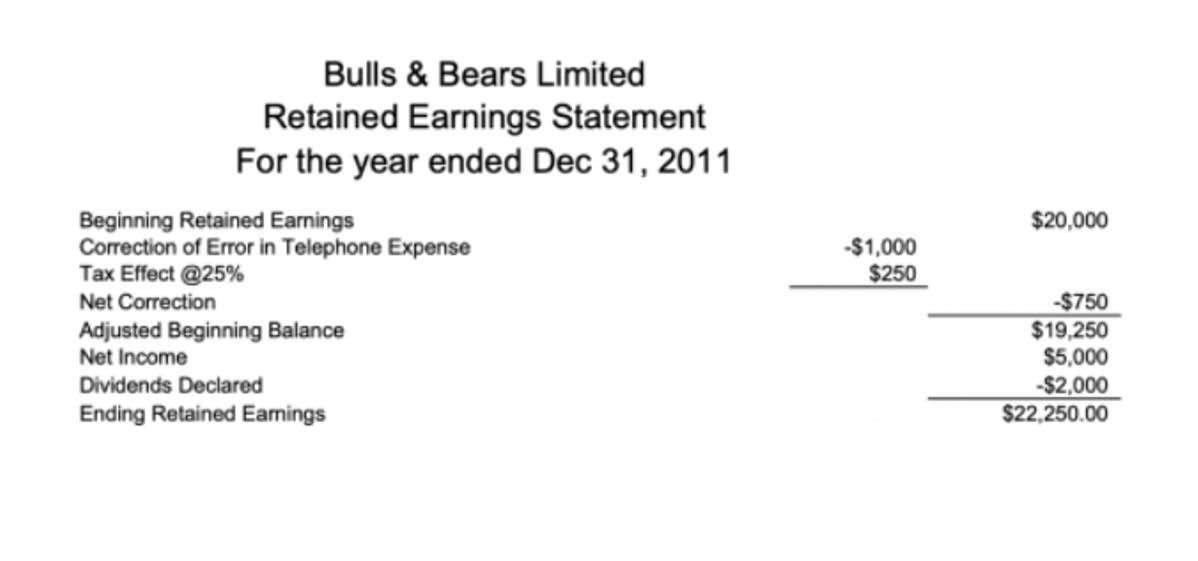
This reduced the company’s equity because share buybacks decreased the capital base and retained earnings. The retention ratio (also known as the net income retention ratio or plowback ratio) is the ratio of a company’s retained income to its net income. The retention ratio measures the percentage of a company’s profits that are reinvested into the company in some way, rather than being paid out to investors as dividends. They then report gain or loss on the sale of their shares like any other capital transaction.
FreshBooks Accounting Software

In financial modeling, it’s necessary to have a separate schedule for modeling retained earnings. The schedule uses a corkscrew-type calculation, where the current period opening balance is equal to the prior period closing balance. In between the opening and closing balances, the current period net income/loss is added and any dividends are deducted. Finally, the closing balance of the schedule links to the balance sheet. This helps complete the process of linking the 3 financial statements in Excel. The key to addressing negative retained earnings is to focus on long-term sustainability and profitability.
- In the former case, valuations for such companies depend on the extent of the temporary problems and how their rate of protraction.
- Retained earnings are the financial embodiment of a company’s past decisions and future possibilities.
- As an equity item, a credit entry to the retained earnings account means increasing the account’s balance.
- Maroof HS CPA Professional Corporation is an Ontario-based professional accounting firm providing business, accounting and tax services in Canada and the United States.
- The retained earnings balance is recorded in the Shareholders’ Equity section of the company’s balance sheet.
- Through these examples, it becomes evident that the management of retained earnings is a delicate balance between seizing growth opportunities and maintaining financial stability.
Is negative retained earnings possible?

However, If a company is wrapping up its operations, then it can make a dissolution or liquidation dividend payment to shareholders regardless of the condition of retained earnings. In this situation a company can pay a dividend with negative retained earnings or that will put retained earnings into a negative position. Explore the financial and legal nuances of paying dividends with negative retained earnings, including impacts and accounting treatments. In QuickBooks Online (QBO), retained earnings is an Equity account that represents the company’s profits to be reinvested or used bookkeeping later. Thus, when retained earnings are negative, their balance shown under the stockholder’s equity on the balance sheet is also negative.
- Dividends are the last financial obligations paid by a company during a period.
- The first entry on the statement should state the balance carried over from the previous year (beginning retained earnings).
- Close monitoring of the target’s financial performance ensures timely corrective actions, enabling the combined entity to move toward long-term financial stability.
- Issuance/declaration of dividends can be generally done at any point of time in a year.
- This is applicable only if you have dividend income only and no other source of income.
- Under IFRS, retained earnings are included in the statement of changes in equity, which must be presented as part of the financial statements.
Why is Apple’s debt ratio so high?
- High operating costs, declining sales, or ineffective cost management contribute to this situation.
- Integrating these strategies into daily and future plans is key for lasting success.
- This scenario may signal financial risk or insolvency to creditors and investors.
- Startups often incur losses as they invest heavily in product development, marketing, and infrastructure before generating consistent revenue.
- These earnings are what’s left after a firm pays out dividends, found in the shareholders’ equity on the balance sheet.
- This figure is adjusted at the end of each accounting period, as reflected in the adjusted trial balance, which accounts for all the financial transactions and adjustments made over the period.
Retained earnings https://mazzacomunicacion.com/liquid-assets-explained-with-examples-uses-and/ are the cumulative net earnings or profits a company keeps after paying dividends to shareholders. Dividends are the last financial obligations paid by a company during a period. “Retained” refers to the fact that those earnings were kept by the company.
Net loss

The cumulative negative churn formula is (Churned MRR-Expansion MRR)/Starting MRR where MRR is monthly recurring revenue. A negative retention rate would mean that the revenue you lose from customer churn is greater than that from retained customers. If the mortgage was paid to an negative retained earnings individual, that lender should have issued a Form 1098 to the corporation. The recipient should issue a Form 1099-INT for the seller financed mortgage interest. This negatively impacts potential investors, but other potential stakeholders like bankers, creditors, large customers, suppliers, and staff also reluctantly rely on the entity.
